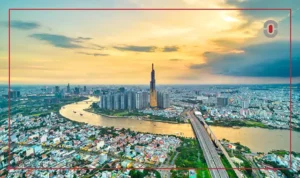Do you know that more than 1.5 million Vietnamese speakers live in the United States, making Vietnamese the fifth most spoken language there? Very large groups of Vietnamese speakers live in California, Texas, and Washington. In the following article we’ll learn more about translation in general, and English-to-Vietnamese translation in particular.
Introduction
In today’s rapidly globalizing business environment, effective communication is essential for success. As Vietnam continues to emerge as a key player in the global economy, the demand for English-to-Vietnamese translation has never been greater. Businesses, from multinational corporations to small enterprises, seek to expand their reach in Vietnam’s thriving market, needing accurate and culturally nuanced translations.
With Vietnam’s increasing integration into global trade, sectors such as technology, e-commerce, finance, and tourism witness a surge in cross-border collaborations. This makes precise translation not just a tool for overcoming language barriers, but also a strategic asset for companies looking to build strong relationships with Vietnamese partners, consumers, and stakeholders. Furthermore, localization—adapting content to reflect local culture, customs, and business practices—plays a crucial role in ensuring that messages resonate effectively with Vietnamese audiences.
Overview of Vietnam’s Economy
Vietnam has emerged as one of the fastest-growing economies in Southeast Asia, positioning itself as a key hub for manufacturing, technology, and tourism. Over the past decade, the country has experienced steady GDP growth (about 6%), fueled by a combination of foreign direct investment (FDI), an expanding middle class, and a strategic emphasis on economic diversification. Vietnam has become a global manufacturing hub, attracting major multinational corporations looking for cost-effective and skilled labor. The country has benefited from supply chain shifts, particularly as companies seek alternatives to China due to rising costs and trade tensions. Industries such as electronics, textiles, footwear, and automotive components have flourished, with tech giants like Samsung, Apple, and Intel investing heavily in production facilities. The country is emerging as a regional leader in software development, artificial intelligence (AI), and fintech, attracting both startups and global tech firms. On top of that, Vietnam’s tourism sector has rebounded strongly post-pandemic, supported by government efforts to ease visa policies and improve infrastructure.
Even though English is widely used in the field of international trade, the clear and effective communication in the Vietnamese language is essential for businesses looking to build strong local partnerships and engage customers successfully. It remains the dominant language for business negotiations, consumer interactions, and government dealings. Companies that invest in high-quality Vietnamese translations and localization gain a significant advantage in establishing trust, credibility, and long-term success. The industries that benefit the most from English-to-Vietnamese translations are e-commerce, healthcare, and education, but also legal and financial services, technology and software, tourism, etc.
Overview of Vietnamese Language. Key Challenges in English-to-Vietnamese Translation
Vietnamese is an Austroasiatic language spoken primarily in Vietnam where it is the official language. It belongs to the Vietic subgroup of the Austroasiatic language family. Vietnamese is spoken natively by around 85 million people. It is written using the Vietnamese alphabet, which is based on the Latin script (thought it was historically written using Chinese characters).
Some key challenges in English-to-Vietnamese translation are:
1. Localization – Tone and Formality Levels – Localization in English-to-Vietnamese translation goes beyond direct word conversion—it involves adapting content to fit the cultural, linguistic, and contextual needs of Vietnamese speakers. Whether for business, media, or software, proper localization enhances engagement, clarity, and acceptance of translated materials.
Vietnamese language and culture have unique expressions, idioms, and references that may not have direct equivalents in English. Localization helps adapt these elements in order to ensure clarity and relatability. It can also be applied to slogans, product names, and marketing messages. For example, KFC’s famous Finger-lickin’ good was localized to Vị ngon trên từng ngón tay (“Delicious taste on every finger”) instead of a direct, awkward translation.
Apart from the obvious linguistic differences, another very important moment in English-to-Vietnamese translation, is the tone and formality levels. Vietnamese has a complex system of pronouns and honorifics that vary depending on social hierarchy, relationship status, and context. The correct choice of words can influence how a message is received and interpreted.
2. Pronoun Usage – Vietnamese has multiple pronouns for “you,” “I,” and other personal references that reflect the speaker’s relationship with the listener. Using the wrong pronoun can appear rude or overly formal.
3. Business Communication – in professional settings, formal language is preferred, and titles such as ông, bà, and anh/chị are used to show respect.
4. Mistranslation of Technical Terms – technical and specialized vocabulary, such as in medicine, law, or technology, often lacks direct equivalents in Vietnamese. Translators may attempt to use loanwords from English or create an approximate Vietnamese equivalent, which can lead to confusion.
The Role of a Vietnamese Translation Agency
A Vietnamese translation agency plays a crucial role in helping individuals, businesses, and organizations effectively communicate in Vietnamese, both within Vietnam and internationally. Its key functions are language translation services (documents, websites, creative writing), interpretation services (consecutive and simultaneous interpretations), localization, specialized expertise, quality assurance, cultural consultation, transcription services, etc.
If you’re looking for a reliable partner to bridge the language gap between English and Vietnamese, 1-StopAsia is your go-to solution. With years of expertise in delivering high-quality Vietnamese and other Asian languages translation services, we specialize in making your message resonate with your target audience—accurately, culturally, and contextually. Our team of skilled linguists, translators, and cultural experts ensures that every translation is not only linguistically precise, but also adapted to the nuances of Vietnamese culture. Whether you need legal, technical, marketing, or creative translation, 1-StopAsia offers customized services that meet your specific needs.
The Future of English-to-Vietnamese Translation
The future not only of English-to-Vietnamese, but of translation in general is shaped by advancements in technology, evolving language dynamics, and increasing global interconnectivity. The main points are:

- Integration of AI and Machine Translation
- Focus on Localization
- Real-Time Translation and Interpretation
- Increased Demand for Specialized Translation
- Crowdsourced and Collaborative Translation
- Human-Technology Collaboration
- Focus on Ethical and Inclusive Translation
- Digital Growth and Global Connections
Conclusion
Investing in high-quality English-to-Vietnamese translation is essential for businesses looking to succeed in Vietnam’s dynamic market. By leveraging professional translators, cultural insights, and localization strategies, businesses can build strong connections with Vietnamese-speaking audiences and drive long-term success. Whether you’re expanding your brand’s global reach or entering the Vietnamese market for the first time, effective translation is key to ensuring clarity, engagement, and credibility.
